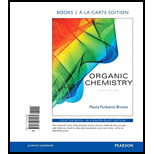
Concept explainers
a)
Interpretation:
The given substituent is ortho-para directors or meta directors are to be determined.
Concept Introduction:
There are two types of
b)
Interpretation:
The given substituent is ortho-para directors or meta directors are to be determined.
Concept Introduction:
There are two types of functional groups present in the compounds. One is electron withdrawing and another is electron donating. Electron donating groups direct the electrophile to ortho and para positions. Electron withdrawing groups direct the electrophile to meta position.
c)
Interpretation:
The given substituent is ortho-para directors or meta directors are to be determined.
Concept Introduction:
There are two types of functional groups present in the compounds. One is electron withdrawing and another is electron donating. Electron donating groups direct the electrophile to ortho and para positions. Electron withdrawing groups direct the electrophile to meta position.
d)
Interpretation:
The given substituent is ortho-para directors or meta directors are to be determined.
Concept Introduction:
There are two types of functional groups present in the compounds. One is electron withdrawing and another is electron donating. Electron donating groups direct the electrophile to ortho and para positions. Electron withdrawing groups direct the electrophile to meta position.
e)
Interpretation:
The given substituent is ortho-para directors or meta directors are to be determined.
Concept Introduction:
There are two types of functional groups present in the compounds. One is electron withdrawing and another is electron donating. Electron donating groups direct the electrophile to ortho and para positions. Electron withdrawing groups direct the electrophile to meta position.
f)
Interpretation:
The given substituent is ortho-para directors or meta directors are to be determined.
Concept Introduction:
There are two types of functional groups present in the compounds. One is electron withdrawing and another is electron donating. Electron donating groups direct the electrophile to ortho and para positions. Electron withdrawing groups direct the electrophile to meta position.
Want to see the full answer?
Check out a sample textbook solution
Chapter 18 Solutions
Organic Chemistry, Books a la Carte Edition (8th Edition)
- Draw the alkynes formed in each reaction. Two equivalents of each base are used. CI CI 11 -NH₂ C–C–CH,CH3 II HH a. b. CH3CH₂CH₂CHC1₂ -NH₂ KOC(CH3)3 DMSO Br T C. CH3-C-CH₂CH3 I Br d. Br Br -NH₂arrow_forward2, 3,3-trimethyl butan-1-01 -> 1-bromo-2,3, 3- trimethyl but ane A. H Br, El B₁ HBV, SHI C- HBr, SN 2 D. PBV3, SN2arrow_forward29 The reaction below forms an organic product that is a racemic mixture. What is the product? A. CH₂ +₂+HO- HOH CI CH₂ + enantiomer HO "B +enantiomer B. а к OH. 1 CH, + enantiomer D. qo + enantiomerarrow_forward
- 22. What are the products of the following reactions? a. 2 b. Br +HO c. CH₂CH₂CH₂CH₂Br 1. C=N 2. H₂, Raney Ni f. CH₂ CH₂ NH₂ CHsLi 1. BF₂/THF CI 2. H₂0 + CH₂CH₂CH₂Br + C6H5N=N CH3 1. NH₂ 2. CH₂CH₂CH₂Br 1. Mg/Et₂O Br 2. CO₂ 3. HCIarrow_forwardS Determine the product(s) for each reaction. HD TSO H X H CI X H H CI H OTS A. B. C. D. HO HO TSO H "H LOH HD TSCI pyridine SOCI₂ pyridine ΚΙ HCI ZnCl₂arrow_forwardWhich of the molecules A through D shown below will give mixtures of enantiomers upon reaction with HCI? A в D O 1. Molecules C and D. O 2. Molecules A and B. O 3. Molecules A and C. O 4. Molecules B and C.arrow_forward
- Tell whether each stereogenic isomer is either R or S. Assign the correct priority of each group comnected to the stereogenic cemter. a. b. c,H d. NH2 .S. OCH, "Br HO HS CHarrow_forward1. Provide the major product for the following reactions. If the reaction creates a racemic mixture, draw only one of the stereoisomers (meaning put wedge and dash bonds on the structure). a. b. C. ZI OMe OH LOTS NaCN DMFarrow_forward15. Give the major organic product, paying attention to stereochemistry (syn/anti). Indicate if a racemic mixture is expected. a. a. BH3 b. H2O2, OH a. BH3 b. b. H2O2, OH a. BH3 a. BH3 C. d. b. H2O2, OH b. H₂O2, OH e. a. BH3 b. H₂O2, OHarrow_forward
- 26. Give the major organic product of each reaction. Indicate if a racemic mixture is expected. Br OH Br₂ Br₂ a. b. H₂O raumic racenie CH30 OH Br2 ICHS a. Br2, H₂O C. d. CH3OH b. NaH Br racemic racer Cl e. Cl₂ JOH OH f. a. Cl₂, H₂O b. NaH racearrow_forward7. Determine the products or reagents need to complete the following reactions. a. (CH3),NH, HgO* 9 d. r 1. EtMgBr 2. H₂O+ Ph₂NH (1 equiv) H₂O+ OH 1) PCC 2) KCN, HCIarrow_forwardWhat are the products of the reaction below? om COH + NH3 COH a. H2N NHČOH b. + H20 Oc. + NH4* O d. CNH2 + H20arrow_forward
 ChemistryChemistryISBN:9781305957404Author:Steven S. Zumdahl, Susan A. Zumdahl, Donald J. DeCostePublisher:Cengage Learning
ChemistryChemistryISBN:9781305957404Author:Steven S. Zumdahl, Susan A. Zumdahl, Donald J. DeCostePublisher:Cengage Learning ChemistryChemistryISBN:9781259911156Author:Raymond Chang Dr., Jason Overby ProfessorPublisher:McGraw-Hill Education
ChemistryChemistryISBN:9781259911156Author:Raymond Chang Dr., Jason Overby ProfessorPublisher:McGraw-Hill Education Principles of Instrumental AnalysisChemistryISBN:9781305577213Author:Douglas A. Skoog, F. James Holler, Stanley R. CrouchPublisher:Cengage Learning
Principles of Instrumental AnalysisChemistryISBN:9781305577213Author:Douglas A. Skoog, F. James Holler, Stanley R. CrouchPublisher:Cengage Learning Organic ChemistryChemistryISBN:9780078021558Author:Janice Gorzynski Smith Dr.Publisher:McGraw-Hill Education
Organic ChemistryChemistryISBN:9780078021558Author:Janice Gorzynski Smith Dr.Publisher:McGraw-Hill Education Chemistry: Principles and ReactionsChemistryISBN:9781305079373Author:William L. Masterton, Cecile N. HurleyPublisher:Cengage Learning
Chemistry: Principles and ReactionsChemistryISBN:9781305079373Author:William L. Masterton, Cecile N. HurleyPublisher:Cengage Learning Elementary Principles of Chemical Processes, Bind...ChemistryISBN:9781118431221Author:Richard M. Felder, Ronald W. Rousseau, Lisa G. BullardPublisher:WILEY
Elementary Principles of Chemical Processes, Bind...ChemistryISBN:9781118431221Author:Richard M. Felder, Ronald W. Rousseau, Lisa G. BullardPublisher:WILEY





